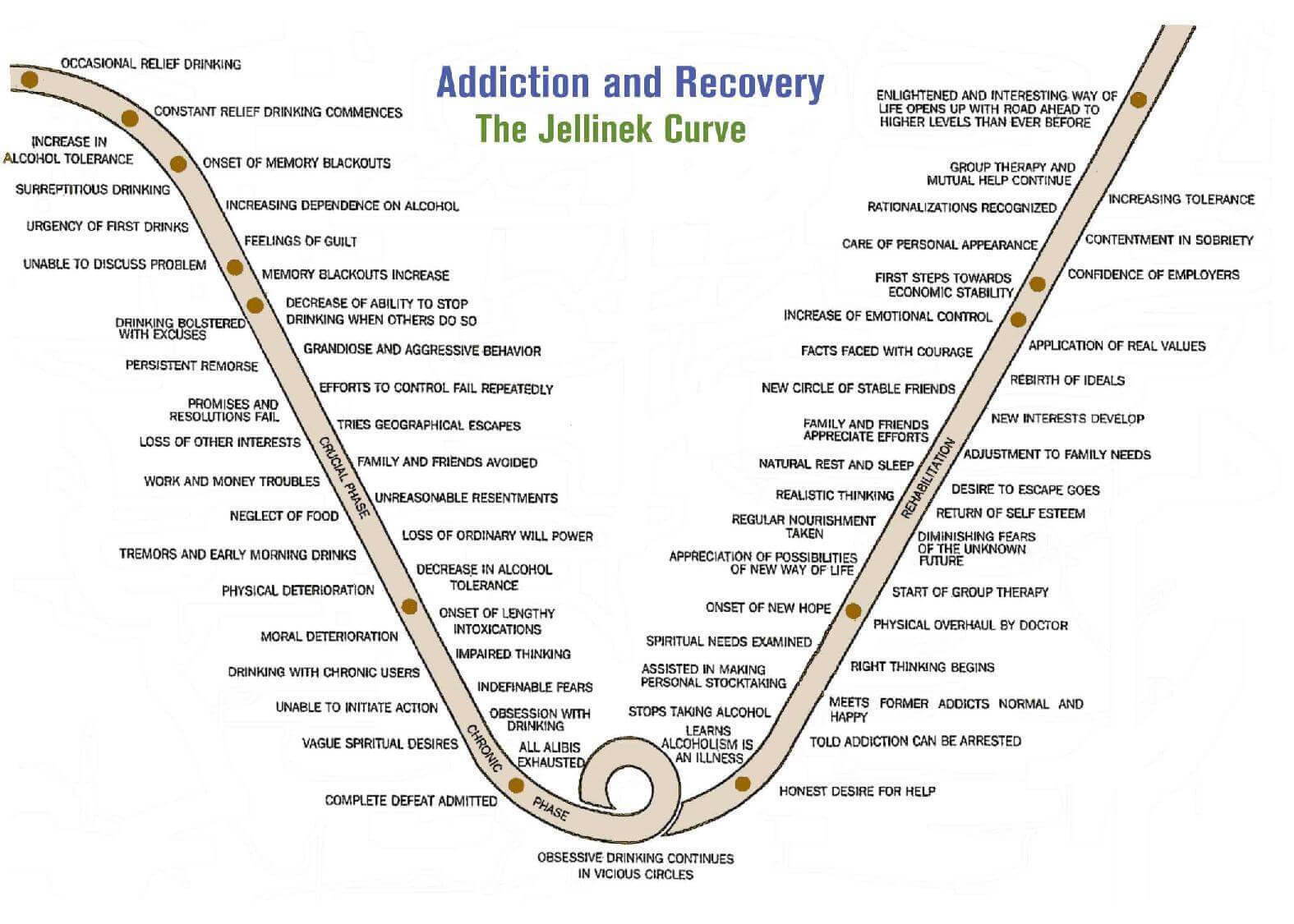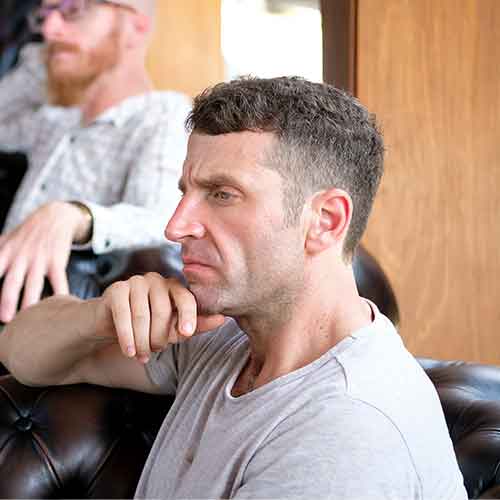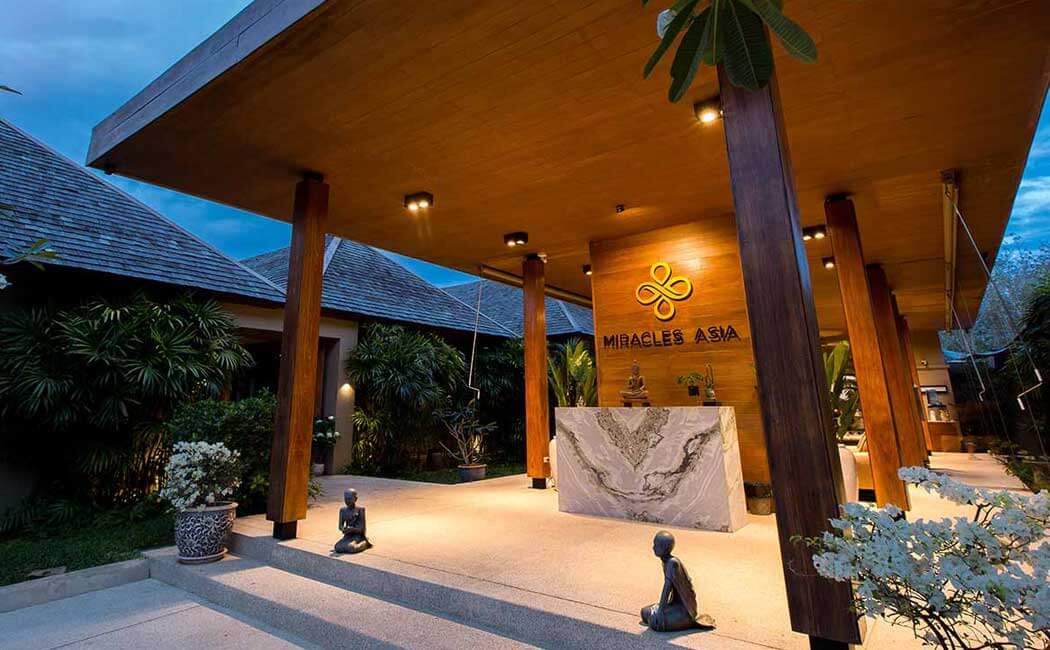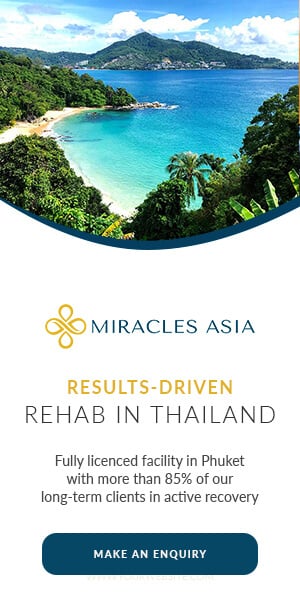Do you ever wonder why some people can have a few drinks and stop while others can't seem to put down the bottle? Having a physical dependence on drinking alcohol is a serious and often misunderstood problem, but there is hope for those who want to stop.
Understanding the Jellinek Curve can help you or your loved one break their active addiction and change their drinking behavior to reclaim a healthier life.
The Jellinek Curve is a visual representation of the stages of alcoholism and recovery created by Dr. E. M. Jellinek, a renowned alcoholism researcher, in the 1940s.
The Jellinek curve describes how a person progresses from occasional drinking to complete dependence, identifying when their recovery process begins.
The Five Stages Of The Jellinek Curve
Stage 1: Pre-alcoholism phase
Stage 2: Early alcoholic or Prodromal phase
Stage 3: Middle alcoholic or Crucial phase
Stage 4: Late alcoholic or Chronic phase
Stage 5: Recovery or Rehabilitation phase
While the Jellinek Curve is useful for understanding the stages of alcoholism and recovery, it's important to note that not everyone's journey through these stages will be the same.
Some individuals may progress through the stages faster than others, and some may skip the stages altogether.
The key takeaway here is that the general progression of the curve can help individuals recognize the signs of a problem and allow them to take action to address their substance use disorder.
Let's explore each stage of the Jellinek Curve in more detail:
Pre-Alcoholic Stage
The pre-alcoholic stage is characterized by occasional or moderate drinking with no signs of physical or psychological dependence on alcohol yet present.
At this phase of the Jellinek curve, individuals may drink socially or to cope with stress. Still, they do not feel they need alcohol to function normally throughout the day, nor do they suffer any negative impacts from drinking, such as changes in mood or attitude, or start to present with mild symptoms of a mental health disorder.
Early Alcoholic Stage
As the individual progresses along the curve, they enter into what is referred to as early alcoholism, which marks an increased consumption of alcohol accompanied by changes in the persons behavior associated with drinking more frequently or heavily than before.
Individuals may start experiencing alcohol withdrawal symptoms when they don't drink, and may begin to have a psychological addiction where they rely on it to relieve anxiety or depression.
Some of these symptoms may include the following:
- Nausea
- Headaches
- Insomnia
They may also neglect responsibilities at home or work due to their increased consumption of alcohol.
Middle Alcoholic or Crucial Phase
The crucial alcoholic stage sees further increases in frequency and amount of drinking as well as their dependence on alcohol becoming more severe.
At this point, a person's decline may become more noticeable as they are increasingly isolated from friends and family due to their inability to control their drinking habits or simply because they are ashamed of how much they consume each day.
They may also start experiencing severe health problems related to excessive drinking, such as early symptoms of liver damage.
Late Alcoholic or Chronic Phase
Individuals at this stage of the Jellinek Curve will have developed a complete physical dependence on alcohol and may experience extreme mood swings when they stop drinking. However, in more cases, they will often continue drinking and engaging in risky behaviors despite knowing the potential consequences involved, like driving while intoxicated and only feeling a very occasional relief drinking as much as they do.
Individuals at this stage will likely find themselves unable to function normally throughout their everyday life without drinking alcohol regularly, and they can experience life-threatening withdrawal symptoms if they stop suddenly.
Recovery Stage or Rehabilitation Phase
Finally, after reaching rock bottom, individuals who have an honest desire to stop drinking will begin their recovery phase and seek out professional help to get sober again through addiction treatment programs like Alcoholics Anonymous (AA) or residential rehab centers where they can receive medical care and counseling services tailored specifically for those suffering from alcoholism.
This rehab process usually involves detoxification followed by therapy sessions designed to help individuals learn how to manage cravings, develop healthier coping mechanisms, build self-esteem, set realistic goals, establish meaningful relationships, etc. so that they can fully recover from reliance on alcohol or drug use.
The Jellinek Curve provides an evidence-based framework for understanding one's progress along each step towards recovery while outlining practical strategies that can be used during each step along the way, including identifying triggers that cause one's addictive behavior(s) so that preventive measures against relapse can be taken if necessary once completing a treatment program successfully.
It also serves as an invaluable source of hope for those seeking help because it reassures them that even though things may seem bleak right now, there is still light at the end tunnel, provided adequate effort has been put into staying sober since completing treatment.
With hard work, support from loved ones, and access to quality treatment programs, many people suffering from alcoholism, drug addiction, and other forms of substance abuse can fully recover and achieve happy, healthy, fulfilling lives free of addiction.
Wrapping Up
In conclusion, the Jellinek Curve is a helpful tool for understanding the stages of alcoholism and recovery. In addition, it can help individuals struggling with alcohol use, and their loved ones recognize the signs of a problem and take action to address it.
One of the key takeaways from the Jellinek Curve is that alcoholism is a progressive disease that can lead to severe physical and mental health problems if left untreated. Yet, recovery is possible, and many resources are available to help individuals overcome their addictions and rebuild their lives.
If you or a loved one is struggling with alcohol abuse, it's essential to seek help. Many different treatment options are available, from support groups like Alcoholics Anonymous to programs like the one available at our Thailand rehab facility in Phuket.
By seeking help, you can take the first step towards recovery and a healthier, happier life.
Remember, recovery is not a linear process, and it's okay to stumble along the way. What's important is that you keep moving forward and stay committed to overcoming alcohol addiction. You can achieve long-term sobriety and a better quality of life with the proper support and resources.







